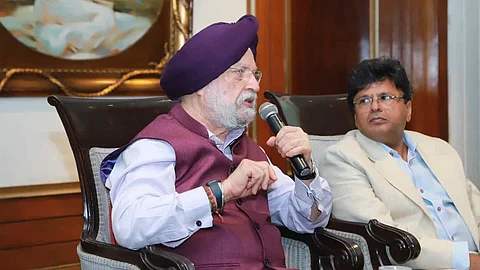
- News Updates
- PSU Watch
- Defence News
- Policy Watch
- हिन्दी न्यूज़
- Jobs Watch
- States News
- Event News

New Delhi: Petrol pumps across India are set for a major transformation, with the government urging them to reposition themselves as “energy entrepreneurs” offering not just fuel but also electric vehicle (EV) charging, rooftop solar, digital payments, and non-fuel revenue services such as battery swapping and financial kiosks. Union Minister for Petroleum and Natural Gas Hardeep Singh Puri outlined this vision while addressing the All India Petroleum Dealers Association (AIPDA) Conclave in Delhi on Thursday. AIPDA is the country’s largest body representing petroleum retail outlet dealers.
“Let this conclave be not just a gathering of peers, but the starting point of a new journey — a journey that takes you beyond retail, beyond margins, and into the very heart of India’s energy transformation,” Puri told attendees, according to an official statement from the Ministry of Petroleum and Natural Gas issued on Friday.
The minister said India’s 70,000-plus fuel retail outlets must prepare for a changing energy landscape by integrating clean energy and digital services. He urged dealers to collaborate with oil marketing companies (OMCs) to install EV charging stations, adopt rooftop solar power, and upgrade their infrastructure with energy-efficient designs.
The statement noted that as India reduces its dependence on crude oil, diversifies its energy mix, and boosts renewables, the physical footprint of petroleum dealers — spanning from Ladakh to Lakshadweep — can be strategically used to enable “accessibility, availability, and affordability” of clean energy.
Puri encouraged petroleum dealers to leverage the prime locations of their outlets to offer non-fuel services like fintech-enabled digital payments, utility bill collection, water kiosks, clean toilets, and battery swapping. He said such diversification would not only enhance customer experience but also unlock new revenue streams.
He called for a transformation in how petrol pumps are perceived and operated, advocating for automated billing, digital dispensing systems, zero pilferage technology, and real-time grievance redressal as new operational norms.
To support this shift, Puri asked the dealer community to upskill their workforce in customer service, digital tools, and safety practices. He emphasised the need for structured training and close coordination with OMCs to meet emerging expectations.
“You are the physical interface between the Indian citizen and the national energy system,” Puri said. “As the energy ecosystem evolves, so must your role — from dealer to energy partner.”
The minister also outlined progress on India’s clean energy goals. As of 2025, India has achieved nearly 20 percent ethanol blending, up from just 1.53 percent in 2014. This shift has saved Rs 1.4 lakh crore in foreign exchange, replaced 238 lakh metric tonnes of crude oil, and reduced 717 lakh tonnes of carbon dioxide emissions, according to the ministry statement.
Other milestones cited include the expansion of compressed natural gas (CNG) stations from 738 in 2014 to over 8,100, and the distribution of 10.33 crore LPG connections under the Pradhan Mantri Ujjwala Yojana (PMUY). The minister called these not just achievements, but “milestones on our journey towards a cleaner, self-reliant energy future.”
While calling for transformation, Puri acknowledged the operational concerns of dealers — including commissions and cost structures — and assured them of the government’s willingness to engage. “We believe in consultation, not confrontation,” he said.
The ministry highlighted that dealer margins had been revised in October 2024, and that intra-state freight rationalisation had been implemented. It also promised continued strengthening of platforms for feedback and grievance resolution.
